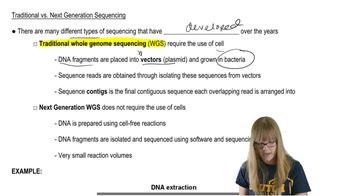Here are the essential concepts you must grasp in order to answer the question correctly.
DNA Polymerase I Function
DNA Polymerase I is an enzyme involved in DNA replication and repair. It primarily functions to remove RNA primers from the lagging strand and replace them with DNA nucleotides. However, its relatively slow synthesis rate and lower processivity compared to other polymerases, such as DNA Polymerase III, raise questions about its efficiency in completing DNA replication in vivo.
Recommended video:
Processivity
Processivity refers to the ability of an enzyme to catalyze consecutive reactions without releasing its substrate. In the context of DNA polymerases, high processivity means that the enzyme can add many nucleotides to a growing DNA strand before detaching. DNA Polymerase I has lower processivity than DNA Polymerase III, which suggests it may not be the primary enzyme responsible for the rapid and continuous synthesis required during DNA replication.
Recommended video:
In Vivo vs. In Vitro
In vivo refers to processes occurring within a living organism, while in vitro refers to studies conducted outside of a living organism, typically in a controlled laboratory environment. The distinction is crucial when evaluating the function of enzymes like DNA Polymerase I, as its activity observed in vitro may not accurately reflect its role in vivo, leading to doubts about its primary function in DNA replication.
Recommended video:
 Verified step by step guidance
Verified step by step guidance Verified video answer for a similar problem:
Verified video answer for a similar problem:

